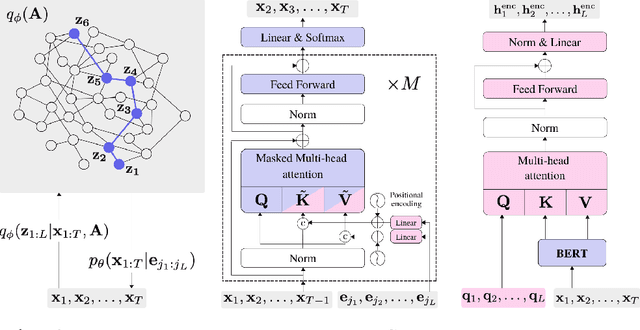Ramsés J. Sánchez
Neural Dynamic Focused Topic Model
Jan 26, 2023Abstract:Topic models and all their variants analyse text by learning meaningful representations through word co-occurrences. As pointed out by Williamson et al. (2010), such models implicitly assume that the probability of a topic to be active and its proportion within each document are positively correlated. This correlation can be strongly detrimental in the case of documents created over time, simply because recent documents are likely better described by new and hence rare topics. In this work we leverage recent advances in neural variational inference and present an alternative neural approach to the dynamic Focused Topic Model. Indeed, we develop a neural model for topic evolution which exploits sequences of Bernoulli random variables in order to track the appearances of topics, thereby decoupling their activities from their proportions. We evaluate our model on three different datasets (the UN general debates, the collection of NeurIPS papers, and the ACL Anthology dataset) and show that it (i) outperforms state-of-the-art topic models in generalization tasks and (ii) performs comparably to them on prediction tasks, while employing roughly the same number of parameters, and converging about two times faster. Source code to reproduce our experiments is available online.
The future is different: Large pre-trained language models fail in prediction tasks
Nov 02, 2022Abstract:Large pre-trained language models (LPLM) have shown spectacular success when fine-tuned on downstream supervised tasks. Yet, it is known that their performance can drastically drop when there is a distribution shift between the data used during training and that used at inference time. In this paper we focus on data distributions that naturally change over time and introduce four new REDDIT datasets, namely the WALLSTREETBETS, ASKSCIENCE, THE DONALD, and POLITICS sub-reddits. First, we empirically demonstrate that LPLM can display average performance drops of about 88% (in the best case!) when predicting the popularity of future posts from sub-reddits whose topic distribution changes with time. We then introduce a simple methodology that leverages neural variational dynamic topic models and attention mechanisms to infer temporal language model representations for regression tasks. Our models display performance drops of only about 40% in the worst cases (2% in the best ones) when predicting the popularity of future posts, while using only about 7% of the total number of parameters of LPLM and providing interpretable representations that offer insight into real-world events, like the GameStop short squeeze of 2021
Hidden Schema Networks
Jul 08, 2022



Abstract:Most modern language models infer representations that, albeit powerful, lack both compositionality and semantic interpretability. Starting from the assumption that a large proportion of semantic content is necessarily relational, we introduce a neural language model that discovers networks of symbols (schemata) from text datasets. Using a variational autoencoder (VAE) framework, our model encodes sentences into sequences of symbols (composed representation), which correspond to the nodes visited by biased random walkers on a global latent graph. Sentences are then generated back, conditioned on the selected symbol sequences. We first demonstrate that the model is able to uncover ground-truth graphs from artificially generated datasets of random token sequences. Next we leverage pretrained BERT and GPT-2 language models as encoder and decoder, respectively, to train our model on language modelling tasks. Qualitatively, our results show that the model is able to infer schema networks encoding different aspects of natural language. Quantitatively, the model achieves state-of-the-art scores on VAE language modeling benchmarks. Source code to reproduce our experiments is available at https://github.com/ramsesjsf/HiddenSchemaNetworks
Recurrent Adversarial Service Times
Jun 24, 2019



Abstract:Service system dynamics occur at the interplay between customer behaviour and a service provider's response. This kind of dynamics can effectively be modeled within the framework of queuing theory where customers' arrivals are described by point process models. However, these approaches are limited by parametric assumptions as to, for example, inter-event time distributions. In this paper, we address these limitations and propose a novel, deep neural network solution to the queuing problem. Our solution combines a recurrent neural network that models the arrival process with a recurrent generative adversarial network which models the service time distribution. We evaluate our methodology on various empirical datasets ranging from internet services (Blockchain, GitHub, Stackoverflow) to mobility service systems (New York taxi cab).
 Add to Chrome
Add to Chrome Add to Firefox
Add to Firefox Add to Edge
Add to Edge